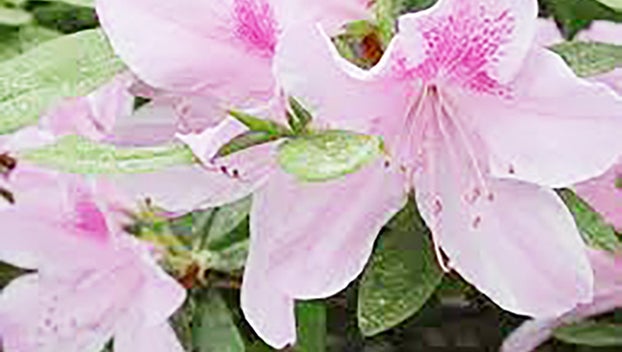Master Gardener: Azaleas are a harbinger of Spring
Published 12:16 am Wednesday, February 16, 2022

- Azaleas are a member of the Rhododendron family. Thw Southeast Texas climate doesn’t favor Rhododendrons. The summers are simply too hot. (Courtesy photo)
|
Getting your Trinity Audio player ready...
|
The first day of spring is March 20, meaning there only remains 5 weeks of winter!
Naturally, our last anticipated frost date according to the Farmer’s Almanac, March 10, which means most of us will begin transplanting vegetable and flowers we have germinated indoors very soon.
If you are anything like me, spring simply cannot get here soon enough!
With each passing week, my anticipation and excitement level builds, as it is pure joy for me to create this year’s flower and vegetable gardens. I’m certain this is the case for all my fellow gardeners!
Every spring as gardeners, we look forward to the Azaleas’ flush knowing cold temperatures of winter are now behind us and jubilant warmth of spring is close at hand.
It’s almost time to begin work on our lawns, flower, and vegetable gardens.
Azaleas are a member of the Rhododendron family. Our Southeast Texas climate doesn’t favor Rhododendrons, our summers are simply too hot!
But the azalea, which is rhododendrons’ 1st cousin can be grown and with some assistance will even flourish here.
Azaleas truly make exceptional focal points in our landscapes and many gardeners build into their garden framework azaleas either with an individual plant or through mass planting azaleas into their landscape.
My preference is an individual azalea bush, neatly tucked away near a structure entryway or beneath a large pine or oak tree provide color with subtlety. But mass planting azaleas will provide for a far greater, more explosive burst of color and choosing a wooded site as the backdrop, such as a pine stand will create an intensive, bold colorful contrast to the grayish-brown back drop.
The color contrast is striking and most often inducing smiles from passersby. Spring flush (blooms) often completely envelope the bush for 2-3 weeks or slightly longer, the remainder of the year the azalea will be a beautiful dark green foliage plant.
There are many varieties of Azaleas and most certainly there is a special variety just for you. Most Azaleas blooms grow in clusters, called “trusses” and are trumpet-shaped 1-2” flowers, though some varieties have up to 4” blooms. Azalea flower colors can be almost any color except blue.
Most colors are in variations of pink, i.e., speckled, blotched, or bicolor. Flowers can also be single or double-petaled or hose-in-hose (one flower in another flower). Providing some initial effort, all gardeners who grow azaleas will be rewarded for many years with wonderful springtime blooms.
Azalea Varieties
Native azaleas are adapted to our region and are more resistant to pests and disease. Many also have a sweet or spicy fragrance. ‘Alabama’ (a personal favorite) has large white flowers with yellow blotches and a lemon fragrance.
It is native to the Southeastern United States and grows well in zones 7-9. ‘Texas’ is slightly fragrant with funnel-shaped flowers which can be either white or pink.
Cold hardy azaleas can be grown through zone 5. ‘Koromo Shikibu’ has pink spidery type flower and is fragrant. Autumn leaf colors can be dark red, purple, orange, and gold, simultaneously.
There also may be some scattered blooms in fall. This azalea is good in zones 5b – 9.
Reblooming azaleas are wonderful to have if you don’t have time to plant multiple azalea varieties with varying bloom times, then consider the reblooming azalea.
They initially bloom in spring and then rest for a spell. Once rested, they then send out another flush of flowers thru the summer. Another benefit of reblooming azaleas, dead heading not required! ‘Autumn Fire’ is a true, rich red with some double blooms in spring.
It will continue reblooming until fall with dark green foliage which turns purple in the fall. ‘Autumn Trust’ (another personal favorite) has large, bicolor flowers which are lavender-pink with dark pink highlights in spring thru fall. Grows well in zones 7-9. ‘Perfecto Mumbo’ (Double Pink) has large pink, double pink flowers in spring thru fall and grows well in zones 7-9.
Late blooming azaleas will extend your blooming season. These are two varieties which bloom well in our climate. ‘Gumpo White’ has large, ruffled, white flowers blooming in early summer, and it is cold hardy in zones 7-9. ‘Plumleaf’ has bright orange to deep red flowers and blooms late summer and grows well in zones 5-9.
Follow these easy steps to plant and grow azaleas successfully:
- For best results, have your soil tested. Don’t waste your time and energy by guessing. You will not guess correctly. It’s much easier to contact your local County Extension Agent. They can provide you information on how to correctly capture soil samples and where to send them for analysis. The cost for the soil analysis is minimal (around $12 to $15) but the resulting information provided by the analysis is invaluable!
- Azaleas require acidic soil.
- Do not plant azaleas deeply, especially in our clay soil. Simply plant the bush1-2” above existing soil grade,
- Provide moist, friable, and well-amended soil. Well-drained soil is a must, or risk losing the plant in winter.
- Azaleas must have afternoon shade or filtered light throughout the day. Morning sun is fine, even preferable.
- During the 1st season or two, do not allow azaleas to dry out until established. Providing regular moisture is necessary for the development of good root systems.
- Do not cultivate the soil around the azaleas drip line. Azalea roots grow close to the surface and are easily damaged.
For more information or to have all your gardening questions answered, contact the Orange County Master Gardeners: Website: https://txmg.org/orange Facebook: Orange County Texas Master Gardeners Association Helpline: (409) 882-7010 Email: extension@co.orange.tx.us. Written by John Green, Certified Texas Master Gardener.





